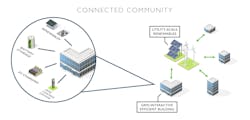How Utilities Can Unlock Grid Reliability and Resilience Through Smarter Flexible Load Management
Safe, reliable, affordable — the mission of electric utilities has remained remarkably consistent and focused for a century. However, rapid changes within the industry and how consumers use energy are redefining how utilities achieve their mission.
Increases in extreme weather, the rise of data centers and other large new loads, and aging distribution grid infrastructure ill-suited to manage the rise of distributed energy resources (DERs) are all pressuring the electric grid’s overall reliability and revealing a lack of resilience.
However, electric utilities are finding new ways to achieve their old goals in this changed operating environment. New tools to achieve grid reliability and resilience are increasingly found on the energy demand side rather than the supply side. As utilities pursue reliability and resilience while managing unique regulatory pressures, market opportunities, and customer expectations, they have a compelling opportunity to balance those needs through demand-side initiatives such as using DERs, advanced grid management systems, and demand response for flexible load management.
Demand-Side Tools in Focus
Every utility faces a unique operating context within its jurisdiction. State laws and regulations set differing priorities for utilities as well as what they can and cannot do. Grid operators, like independent system operators, create market opportunities in one service territory that aren’t available in the next. Customers in one region aggressively adopt electric vehicles (EVs) and rooftop solar, while those in the next show little interest.
That said, demand-side technologies and programs should be part of every utility’s strategy to achieve grid reliability and resilience, respond to regulatory pressures, capture market opportunities, and meet customer expectations. The only question is how to design, model, and implement these programs in a way that is tailored for each specific context.
These demand-side management opportunities broadly fall into four categories.
- Energy efficiency: Energy conservation and efficiency programs have been a foundational strategy for utilities for decades, and cost-effective programs should remain at the forefront of every utility’s list.
- Load flexibility: Many utilities now offer some form of load flexibility program, though these range broadly from basic message alerts to customers during times of emergency to direct utility control of customer thermostats or other customer-owned resources. With the right program design, technologies, and data and analytics, utilities can move past emergency-only load-reducing demand response to deploy it more often as a reliable and flexible resource in their resource stack, along with traditional generation resources.
- Managed EV charging: As with demand response, the key for utilities balancing supply and demand isn’t always about how much electricity is used, but when it is used. As EV adoption continues to grow, utilities can flatten their load curves by shifting demand to non-peak hours and develop vehicle-to-grid capabilities to solve localized distribution grid-level issues.
- DER management: In the early days of rooftop solar, DERs were often framed as a threat to grid reliability. However, the rise of affordable battery energy storage systems and advanced technical strategies like Flexible InterconnectionSM, coupled with resource management systems (e.g., energy orchestration platforms, ADMS, or DERMS), has turned DERs into allies that offer many grid resilience and reliability benefits when optimized.
Smarter Utility Load Flexibility in Action
Supported by one of the U.S. Department of Energy’s 10 Connected Communities grants announced in 2021, PacifiCorp launched a large-scale program to manage solar DERs, water heaters, battery energy storage systems, EV charging, and more across 700 Salt Lake City, Utah, area buildings and apartments. Each is equipped with smart technologies to optimize the collective energy use and provide grid services at scale.
The project aims to seamlessly integrate the building spaces — which include single- and multifamily residential, commercial, industrial, and public buildings — into PacifiCorp’s daily grid operations, creating more than 8 MW of managed load by linking thousands of systems, equipment, and plug loads from across the Salt Lake City region.
PacifiCorp’s goal is to create a holistic approach to coalesce, manage, and coordinate flexible power resources, according to the DOE. EPE supports the overarching goal by helping PacifiCorp achieve several project outcomes: grid services, such as frequency response and peak load management; energy efficiency coupled with customer engagement, recruitment, and retention; cybersecurity at the highest standard; scaling and replicating project outcomes more broadly; and business model analysis to evaluate future opportunities.
The Value of Partnership
EPE is a core member of the team supporting PacifiCorp’s Connected Communities project. Utilities should consider a trusted partner as they work to deploy more advanced demand-side programs for four key reasons.
- A trusted partner can provide a proven framework to design, model, and implement programs tailored to the utility’s specific context — what they’re already doing and what they could do based on regulatory, policy, and market factors.
- Keeping up with every emerging technology is a challenge, but a partner with the right expertise can provide reliable technology evaluation with an understanding of the utility’s technology landscape and what systems it needs.
- Utility program teams often prioritize regulatory requirements, customer experience, and program design and implementation. However, more integration of these programs with utility resource planning, transmission planning, and distribution planning teams is critical. A partner can help a utility work across departments to connect smarter demand-side management to overall strategy.
- Every utility has a different strategic view of its role with customers. Some might want to “own” the relationship, while others simply want to create pathways for others, such as DER aggregators, to provide the market offerings customers want. A trusted partner understands a utility’s ethos and helps it align demand-side management efforts accordingly.
The typical demand response program runs into a wall once it reaches about 10-15% customer adoption. Imagine if that was boosted to 25-50% participation. The outcome would be a stronger, reliable, dispatchable resource with less impact on individual customers. With the customer, technology, data analytics, and marketing expertise the right partners bring to bear, that's just one example of what utilities could achieve — just when smarter load management is needed to achieve the utility mission most.
Sponsored By:
About the Author
Sarah Chatterjee
Senior Director of Electrification Strategy and Programs, Electric Power Engineers
Sarah Chatterjee is an energy service professional that has been in the energy and electric utility industry for over 17 years. She is currently the Senior Director of Electrification Strategy and Programs at Electric Power Engineers and has spent her career working with customer-sited energy technologies to deliver grid services and benefits through demand response, energy efficiency, transportation electrification, building electrification, battery energy storage systems, and distributed generation. Sarah is passionate about clean energy solutions, customer programs, and strategic design, implementation, and integration of behind-the-meter technologies for the purpose of delivering energy savings, operational efficiencies, consumer benefits, and resiliency. Prior to joining Electric Power Engineers, Sarah worked for electric utilities delivering these programs, technologies, and grid services.



